A GG Selfie
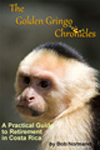 |
Publisher's Corner
If you would like to read a version of
the Golden Gringo Chronicles
in a narrative format,
as a hard-copy novel
or an e-book
check it out HERE
Now Available on Amazon.com Including Kindle!
Mariposa, A Love Story of Costa Rica (English Version)
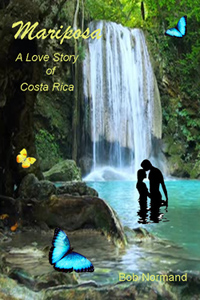 Five hundred years before the Spanish found the American
continent, around the end of the first millennium, Native Americans lived and prospered in Central America, including the land now known as Costa Rica. Truly a natural wonderland then and now, the natives were able to employ their farming skills and prosper from the rich soils, the forests filled with game, herbs, and spices, and the lakes and two oceans rich with fish and crustaceans.
Five hundred years before the Spanish found the American
continent, around the end of the first millennium, Native Americans lived and prospered in Central America, including the land now known as Costa Rica. Truly a natural wonderland then and now, the natives were able to employ their farming skills and prosper from the rich soils, the forests filled with game, herbs, and spices, and the lakes and two oceans rich with fish and crustaceans.
Mariposa, or butterfly, is a story about two young Native Americans, each a favored child of a chief, but of different tribes. These two tribes, historically hostile to each other, lived a few days march apart in the mountains north and east of Costa Rica’s central valley.
The two natives meet by accident, fall in love and begin to plan a life together only to be frustrated by events beyond their control. The lovers are eventually drawn to a mountain volcano which is thought by many to be the home of the gods, particularly Sib'ö, the Great Spirit, who they believe had created the world.
The story as written incorporates the classic ending of Costa Rica's Legend of Zurqui, one that reflects the beauty, mystery and spirituality that is Costa Rica.
Preview the Book on Amazon.com at: Mariposa Preview
(This is Chapter 1 in its entirety)
ORDER IT HERE ($8.95): Mariposa on Amazon.com
(Kindle Version Available - $6.99)
___
¡Acaba de publicar!
Mariposa, una historia de amor de Costa Rica (Versión en Español)
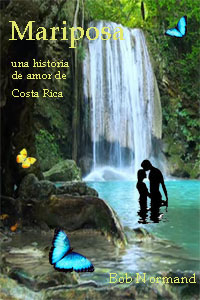 Quinientos años antes de que los españoles encontraran el continente Americano, cerca del final del primer milenio, nativos americanos vivieron y prosperaron en Centroamérica, incluyendo la tierra ahora conocida como Costa Rica. Al ser en verdad una maravilla natural entonces y ahora, los nativos fueron capaces de emplear sus habilidades agrícolas y prosperar gracias a su fértil suelo, al bosque lleno de presas, hierbas y especias, a los lagos y a dos océanos ricos en peces y crustáceos.
Quinientos años antes de que los españoles encontraran el continente Americano, cerca del final del primer milenio, nativos americanos vivieron y prosperaron en Centroamérica, incluyendo la tierra ahora conocida como Costa Rica. Al ser en verdad una maravilla natural entonces y ahora, los nativos fueron capaces de emplear sus habilidades agrícolas y prosperar gracias a su fértil suelo, al bosque lleno de presas, hierbas y especias, a los lagos y a dos océanos ricos en peces y crustáceos.
Mariposa es una historia sobre dos jóvenes nativos americanos, los dos hijos privilegiados de un jefe, pero de diferentes tribus. Estas dos tribus, históricamente hostiles entre ellas, vivían a unos pocos días de marcha de distancia en las montañas del norte y del este del valle central de Costa Rica.
Los dos nativos se conocen por accidente, se enamoran y comienzan a planear su vida juntos, que se frustra únicamente por eventos más allá de su control. Los amantes son arrastrados a un volcán el cual muchos creen que es el hogar de los dioses, particularmente de Sib’ö, el Gran Espíritu, que creen que fue quien creó el mundo.
Como estas historias son leyendas, involucran una buena cantidad de mito, lo que deja tanto al escritor como al lector la libertad de especular diferentes desenlaces. La historia como está escrita incorpora el final clásico de la legenda de Zurquí, que refleja la belleza, misterio y espiritualidad de Costa Rica.
PEDIR EL LIBRO AQUI ($8.95): Mariposa (Versión Español)
(versión kindle disponible - $6.99)
___
See All the Books by GG Here: Books by Bob Normand
Broken News
(All the News That's Fit to Reprint)
The Best Exchange Rate
The current colon-dollar exchange rate as I write this is 561/548. The larger number is always what you pay to buy a dollar and the smaller number is what you get when you sell a dollar. You may hear people quote "buy" or "sell" rates but to people on both sides of a currency transaction those terms can mean different things, so I long ago got used to the larger/smaller definition I used in the second sentence. For a quick summary of the current rates go here: COCORI and for more detailed information on exchange rates use the Banco Central de Costa Rica website (Central Bank of Costa Rica) here: BCCR.
 But maybe you've got billions of colones and you'll be lucky to hit a great exchange rate, like 5.555 colones per dollar. A recent quirk in the system used by BCCR put that rate into play for a (very) short period recently. That means buying $1,000 would have cost you only 5,555 colones instead of the 561,000 colones it should have based on the real rate above. The press reported that two different transactions buying dollars were completed during this period, one for $400,000 and one for $63,000. BCCR authorities were busy getting their money back following those deals.
But maybe you've got billions of colones and you'll be lucky to hit a great exchange rate, like 5.555 colones per dollar. A recent quirk in the system used by BCCR put that rate into play for a (very) short period recently. That means buying $1,000 would have cost you only 5,555 colones instead of the 561,000 colones it should have based on the real rate above. The press reported that two different transactions buying dollars were completed during this period, one for $400,000 and one for $63,000. BCCR authorities were busy getting their money back following those deals.
You probably would have noticed the rate was off though, if someone tried to give you five and a half colones for one buck.
¡Pura Vida!
Ticos Beat Gringos
Snow is an un-natural thing to a Tico and especially so when it occurs during a futbol game.
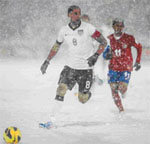 Back in 2013, in the midst of furious competition for a birth in the upcoming FIFA World Futbol Games scheduled for 2014, the Tico national team met the U.S. national team in Denver and fought it out to a 1-0 win for the U.S., in the middle of a snow storm (see It's Snow Joke). The story around here is that the Tico team, who went on to the quarter finals while the U.S. dropped out early, has never forgiven the gringos for playing in the white stuff. They've been seeking revenge ever since.
Back in 2013, in the midst of furious competition for a birth in the upcoming FIFA World Futbol Games scheduled for 2014, the Tico national team met the U.S. national team in Denver and fought it out to a 1-0 win for the U.S., in the middle of a snow storm (see It's Snow Joke). The story around here is that the Tico team, who went on to the quarter finals while the U.S. dropped out early, has never forgiven the gringos for playing in the white stuff. They've been seeking revenge ever since.
National Stadium at Night
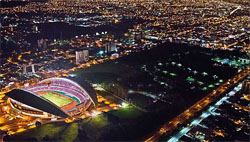 |
They got it big time with the latest game between the two CONCACAF teams (Confederation of North American, Central American and Caribbean)at the National Stadium in San José on the night of November 15 just passed. The ticos beat the gallo pinto out of the gringos four-zip (4-0). This is how the Los Angeles Times put it: “U.S. suffers embarrassing loss to Costa Rica, in the most one-sided loss for the Americans in World Cup qualifying since 1980 — and the most one-sided shutout loss in 59 years.”
Keylor Navas at Work
 |
Because it was a qualifier for the FIFA world cup in 2018, Keylor Navas, a native Costa Rican, came back from his job in Spain playing for Real Madrid. He goaltended for the Ticos and shut out his favorite team to beat. You may remember that Navas reportedly received a one million dollar per year contract from Real Madrid after his stellar performance for the Tico team in the 2014 World Cup.
On the night of the recent game I was working on the computer and not watching television, but I could guess what was happening. It's always easy in Quepos to know when the national team scores a "goalie" because the entire town erupts in loud cheers that are unmistakable and easily heard across the entire village (yes, everybody watches these games). I counted three goals (cerveza-laden screams are probably a better description); I must have missed the fourth.
¡Pura Vida!
Ortega Wins Again
While the Dems and Repubs were thrashing it out in the U.S. election, the Nicaraguans also had a national election on Sunday, November 6 and voted their perennial leader, Señor Daniel Ortega back into office for the third time.
The government estimated that in the final count Sir Daniel would receive 70%+ of the vote, the second candidate getting only 16% and the four other candidates getting the rest. Reports stated that 3.8 million were eligible to vote out of a population of 6.1 million. Government officials claimed a 65% turnout but the opposition claimed 70-80% abstention. Press reports stated that activity at the polls was indeed much lighter than previous elections.
Mr. and Mrs. Nicaragua
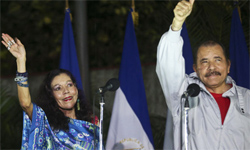 |
One new twist this time was the election of a new Vice President, Señora Rosario Murillo, who just happens to be Ortega's wife. Sra. Murillo had been an important spokesperson for the administration for years. So now we have Mr. and Mrs. Ortega heading into the third decade as Mr. and Mrs. Nicaragua.
Ortega ran Nicaragua from 1979-1990, then was re-elected in 2007. I believe that means he's been ruling Nicaragua (excuse me, serving as President) for 20 years with at least another four to go. When he was first re-elected in 2007, a constitutional one-term limit had been included in the constitution but Ortega obtained (engineered) a court ruling to allow him to run again. In 2014, a constitutional amendment was passed to allow for an unlimited number of terms, essentially assuring Ortega his presidency for life.
Guaro Sales Down
 The national government of Costa Rica finds itself in some odd commercial situations, unfortunately it is often by bureaucratic design. One division of the government, RECOPE, is supposedly responsible for the refining of gasoline but actually refines nothing. Instead it has been made into a price-fixing monopoly, controlling the import and distribution of gasoline (current per gallon prices mid-November, Costa Rica Super - $3.90 and in Florida - $2.11).
The national government of Costa Rica finds itself in some odd commercial situations, unfortunately it is often by bureaucratic design. One division of the government, RECOPE, is supposedly responsible for the refining of gasoline but actually refines nothing. Instead it has been made into a price-fixing monopoly, controlling the import and distribution of gasoline (current per gallon prices mid-November, Costa Rica Super - $3.90 and in Florida - $2.11).
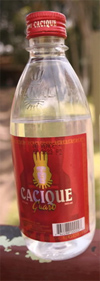 The Costa Rican government is also in the liquor production business, having started it as a monopoly in 1853. That's only 32 years after declaring independence from Spain). A government department called FANAL or Fábrica Nacional de Liquores (National Liquor Plant) makes guaro, a simple distillate of crushed sugar cane. It's been making it ever since 1853 and now markets it under the trade name Cacique ("Chief", in honor of indigenous tribe chieftains).
The Costa Rican government is also in the liquor production business, having started it as a monopoly in 1853. That's only 32 years after declaring independence from Spain). A government department called FANAL or Fábrica Nacional de Liquores (National Liquor Plant) makes guaro, a simple distillate of crushed sugar cane. It's been making it ever since 1853 and now markets it under the trade name Cacique ("Chief", in honor of indigenous tribe chieftains).
The stuff is a 60-proof (30% alcohol) clear, cheap liquid. A half liter plastic bottle of Cacique goes for about $3, which is why it's a favorite among the rummies of Quepos and San José and among people of modest means virtually everywhere else in Costa Rica .
Recently, the Fábrica reported that sales of Cacique for the first nine months of 2016 were down a little over 12%. That triggered a grilling session of Fabrica management at the National Assembly because if sales drop, so do government revenues. A side question was brought up by one assemblyman who asked why the state is involved in liquor production at all (good question amigo - you might also ask the same question of RECOPE and oil).
For years the government product was a monopoly but in recent years several other brands of guaro have appeared on shelves next to the Cacique. Is it just competition effecting Cacique sales? Might the government fare better if it sold the business to a competitor and used the proceeds to benefit the problems caused by liquor, like a rehab center? Just a thought.
Treasurer Island Find
Isla de Coco, Costa Rica
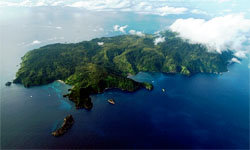 |
One of the least visited National Parks in Costa Rica, and also one of the most beautiful, is on Isla de Coco, a gem of an island some 550km (340 miles) west of the Nicoya Peninsula in the Pacific Ocean. That location of course is why it is not often visited.
The island (about 50 square kilometers or 19 square miles in area) is protected and administered by a governmental department called SINAC (Sistemas Nacional de Areas de Conservación - National System of Conservation Areas) under their MINAE division (Ministerio de Ambiente y Energía - Ministry of Environment and Energy). Didn't I tell you Costa Ricans love acronyms? There are no permanent inhabitants of the island besides park staff, and visitors may not come ashore, even temporarily, unless they have a special permit from MINAE.
Michael Crichton said it was this island that was his model when he wrote Jurassic Park even though the movie was eventually filmed in Maui (my guess is MINAE would not allow them to film a movie on Isla de Coco anyway). Jacques Cousteau filmed several of his underwater episodes there, calling it the most beautiful island he had ever seen. Part of the island's mystique is the legend that a treasure is buried there. In 2011, the Chronicles carried a story about this island and its legend, see it here:
Isla de Coco: A Legend of Treasure Island.
 The legend has it that back in 1820 the Spanish church in Lima, Peru feared that it's treasure would be confiscated in an uprising there. They contracted a British privateer to haul the treasure away but, in keeping with good pirate fashion, he decided to abscond with the loot himself and the story goes he buried it on Isla de Coco. The first Costa Rican governor of the island spent 18 years (circa 1790) trying to find the treasure to no avail. Over the ensuing years treasurer hunters, even using sonar and other modern detection equipment, also failed to turn up the loot.
The legend has it that back in 1820 the Spanish church in Lima, Peru feared that it's treasure would be confiscated in an uprising there. They contracted a British privateer to haul the treasure away but, in keeping with good pirate fashion, he decided to abscond with the loot himself and the story goes he buried it on Isla de Coco. The first Costa Rican governor of the island spent 18 years (circa 1790) trying to find the treasure to no avail. Over the ensuing years treasurer hunters, even using sonar and other modern detection equipment, also failed to turn up the loot.
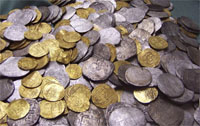 Now, almost 200 years later, just a few weeks ago, a couple of park rangers were wandering one of the beaches on Coco to check turtle nest damage after a big storm and noticed the corner of a wooden chest sticking out of the sand, Upon investigation, it turned out to be the treasure. So far the findings have produced the following:
Now, almost 200 years later, just a few weeks ago, a couple of park rangers were wandering one of the beaches on Coco to check turtle nest damage after a big storm and noticed the corner of a wooden chest sticking out of the sand, Upon investigation, it turned out to be the treasure. So far the findings have produced the following:
- two life-size solid gold statues of the Virgin Mary
- 36 crosses and 3 chalices adorned with precious stones
- 89,000 coins, ingots and artifacts of gold and silver
Total current value of the find is estimated at around $200 million. The religious nature of the materials suggest the items were indeed a part of the Treasure of Lima, distinguishing it from at least two other treasures from other places and times in history that are also reported to be buried there.
There will likely be some discussion about who owns the treasure, including claims from the Vatican, and also on how much of it should end up in museums.
I sure hope the park ranger dudes get something more than an aguinaldo for finding the stuff (and reporting it).
No More Candles
Left to Right
Standing: Yadira Madrigal, Brian Madrigal, Brian's Fiancee Carla, Marvin Madrigal
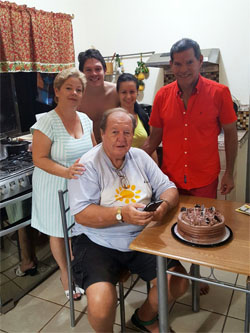 |
If this is how people get treated when they get older I'm all for it! The Golden Dude celebrated the 24th anniversary of his 49th birthday on November 27 (for those of you who are arithmetically challenged that means I was 73 and counting).
On my birthday I treated myself to breakfast in beautiful downtown Quepos and then met with a few expat friends for a couple of hours to chew the fat, then got treated to lunch by a couple of close friends that concluded with a birthday cake with apple sauce, Tico style (yummers). The entire day was punctuated with umpteen Facebook greetings and emails coming in with Happy Birthday wishes. All three of my kids called to chime in.
I had no sooner congratulated myself for eating a light dinner when my landlord's son David Madrigal, who's working in Heredia, called to wish me happy birthday and tell me I should head down to his parents house (in the same compound as my apartment) for some cake. Dude, two birthday cakes in one day - gruesome! It was a deliciously sinful chocolate thing with three or four candles on it (the kind you can't blow out) - wisely, they knew they would have needed a fourteen square meter sheet cake to get 73 candelas on it.
I went to bed that night extremely grateful to have such good family (U.S. and Costa Rica) and good friends.
¡Solo Bueno!
TOP
Rumble and Weather Talk
(Shaky Happenings On or About the Pacific Rim + Weather)
Rumble talk, i.e., earthquake reports, were relatively minimal this month although Turrialba continues to growl and throw out ash periodically.
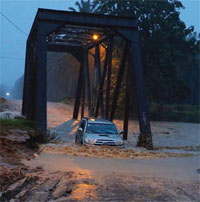 The real news in November came in the form of rain, lots of rain, some of it with incredibly strong winds. October and November are the high months of the rainy season in Costa Rica and this year they lived up to their reputation. By mid-October the government had issued a "green" alert for residents to watch out for mud slides, falling trees and flooding rivers. Some areas, particularly the Nicoya and Osa peninsulas, got four or five inches in a few hours. One report from the Osa measured as much as 400 mm (16 inches) over a three day period, causing serious flooding in the larger towns there like Golfito and Puerto Jimenez. While we in the Quepos area got plenty of rain, it was not that severe.
The real news in November came in the form of rain, lots of rain, some of it with incredibly strong winds. October and November are the high months of the rainy season in Costa Rica and this year they lived up to their reputation. By mid-October the government had issued a "green" alert for residents to watch out for mud slides, falling trees and flooding rivers. Some areas, particularly the Nicoya and Osa peninsulas, got four or five inches in a few hours. One report from the Osa measured as much as 400 mm (16 inches) over a three day period, causing serious flooding in the larger towns there like Golfito and Puerto Jimenez. While we in the Quepos area got plenty of rain, it was not that severe.
And then there was the hurricane. Hurricanes hardly ever happen in happyland, it's too far south. The general rule is anything below 10º latitude is safe (Quepos is at 9º) and, according to press reports Costa Rica has never taken a direct hit from a hurricane since storm records began in 1851. But mother nature doesn't always play by the rules, so in mid-November a rare, late-season hurricane named "Otto" formed in the southwest caribbean and slowly (6 km/hour) moved up the caribbean coast of Central America, gathering strength from the warm waters. It started as a tropical depression off Colombia and turned into a Category One hurricane as it passed Panama, where at least four deaths in landslides were recorded.
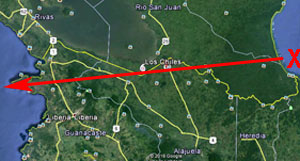 Otto ended up as a Cat 2 just north of the border between Costa Rica and Panama and on November 24 it smashed into southeast Nicaragua near an area called Greytown (red X on map right). From there it proceeded west and entered Costa Rica overland near the center of the country, near a town called Los Chiles just south of Lake Nicaragua.
Otto ended up as a Cat 2 just north of the border between Costa Rica and Panama and on November 24 it smashed into southeast Nicaragua near an area called Greytown (red X on map right). From there it proceeded west and entered Costa Rica overland near the center of the country, near a town called Los Chiles just south of Lake Nicaragua.
This was a narrow gauge storm (my terminology, meaning it was not hundreds of miles wide) and quickly began to dissipate over land, but it still raised havoc along its path. Flooding, downed trees and mud slides produced at least ten fatalities, plus additional missing persons and thousands of displaced persons in Costa Rica.
Futsal as Shelter
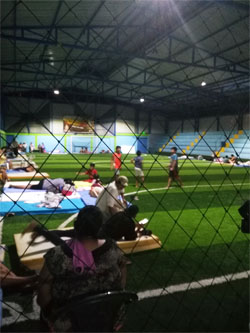 |
Flooding In Guanacaste
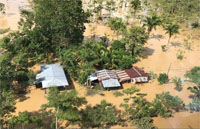 |
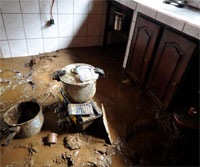 |
It was not clear from press reports whether or not the storm was hurricane strength as it entered Costa Rica or if it had dissipated enough to be downgraded to a tropical storm, which did occur the day after it entered.
That's only a talking point however, as reports put at least ten dead and a further number missing in the north as well as widespread damage that is still being evaluated. The storm seemed to increase its travel speed as it dissipated and by the morning of the 25th it had exited the Pacific side of the country and was well out to sea.
We in Quepos and the surrounding area were not effected by the winds of Otto but we did get a good deal of rain. What was going on was brought home to me on the 24th when I wandered down to the local futsal (indoor futbol arena) only to find the arena had been converted into a storm shelter and was occupied by several dozen refugees, reportedly from Guanacaste.
Our visitors would be there several days before it would be safe enough for them to return home. We were back in the futbol business by Monday, November 28th while the poor evacuees had been returned to Guanacaste to face cleaning up the mud and water and wind damage. In the north part of the country several rivers reached as much as 40 feet (!) above normal. As we go to press, it's still early in the assessment stage and much will have to be done to overcome the damage and potential after-effect of Otto, such as increases in mosquito borne diseases like zika, dengue and chikungunya.
Hopefully Otto signals the end of the rainy season and we can get on to another normal, sunny Costa Rican summer.
¡Pura Vida!
Check Out Recent Earthquakes Around the World
Posted by the U.S. Geodetic Survey:
Today's Quakes |
Search the Golden Gringo Chronicles Archives for Topics That Interest You
You can use our Archives to find everything that has been written in over 200 feature articles of the Golden Gringo Chronicles plus find Broken News items and ROMEO restaurant reviews. Enter your topic or item to search in the Google Search Routine below and follow the links offered from the search results. Suggestion: Enter only a simple, precise and unique as possible keyword or two in order to narrow the number of references retrieved:
Golden Gringo Chronicles - Enter Search Here
Readers: Our publication is open to suggestions regarding future
articles and will accept pieces written by others but we reserve the right to decline
anything that the
editorial staff (that's GG) thinks is inappropriate for this format.
Send proposals, comments, suggestions, ideas, meaningless statements and
jocular observations concerning the Chronicles to GG here: gg@goldengringo.com.
¿Que Es Eso? Department
(What is This?)

If you've been diligent in reading this edition of the Chronicles to this point, you can probably
guess at what this is.
If you don't know, check out the
What's-in-a-Word section below.
GGC 100th Anniversary
(Anatomy of a Newsletter)
This is the One Hundredth Edition of the Golden Gringo Chronicles.
Yup, it's been over eight years since the future Golden Gringo emigrated to Ticoland from chilly Florida. It is chilly there, amigos, chilly by Costa Rica standards, at least from December through February. GG began his retirement September 21, 2008, his first day living here as a permanent expat resident.
 To see how far the Chronicles have come, or just for a good laugh, check out the first edition (which was subsequently labeled Edition "0") here: Golden Gringo Chronicles First Edition. Edition 0 is particularly amusing because it recounts the experience GG had when he made the decision to drive down here through five Gulf of Mexico states; Florida, Alabama, Mississippi, Louisiana and Texas. After that, the plan was to cross five countries; Mexico, Guatemala, Honduras, Nicaragua and finally, Costa Rica. Fate, or maybe it was just accepting the common sense offered by people I met along the way who knew better than me, changed that plan after a series of roadblocks in my strategy popped up. Edition 0 recounts what happened to change my mind. I ended up flying down on a pre-purchased ticket that I intended to abandon in favor of taking the car.
To see how far the Chronicles have come, or just for a good laugh, check out the first edition (which was subsequently labeled Edition "0") here: Golden Gringo Chronicles First Edition. Edition 0 is particularly amusing because it recounts the experience GG had when he made the decision to drive down here through five Gulf of Mexico states; Florida, Alabama, Mississippi, Louisiana and Texas. After that, the plan was to cross five countries; Mexico, Guatemala, Honduras, Nicaragua and finally, Costa Rica. Fate, or maybe it was just accepting the common sense offered by people I met along the way who knew better than me, changed that plan after a series of roadblocks in my strategy popped up. Edition 0 recounts what happened to change my mind. I ended up flying down on a pre-purchased ticket that I intended to abandon in favor of taking the car.
The original Chronicles were not labeled with that name until I had lived here almost a year. A couple of friends said they enjoyed the e-mail write-ups I had been sending periodically so "keep sending them". Eventually I hit upon the idea of making them a monthly email and somewhat later I started calling it a monthly newsletter. I began featuring not only my personal experiences but various articles about the culture and history of both the Quepos/Manuel Antonio area and Costa Rica as a whole. As GG gained more experience, the scope was broadened to include other Latin America countries and, in particular, Costa Rica's neighbors to the north and south, Nicaragua and Panama.
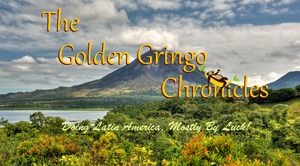 Eventually GG hit upon the name Golden Gringo Chronicles and renamed the newsletter using that title. Gringo (the more polite word is Norteamericano) is a mildly pejorative term in Costa Rica; Ticos smile when you use that term on yourself. The Golden part of the name was chosen for two reasons; 1) retirement time might also be thought of as the "golden" years and 2) I felt fortunate that I was able to retire here, I was "golden" or lucky in that regard.
Eventually GG hit upon the name Golden Gringo Chronicles and renamed the newsletter using that title. Gringo (the more polite word is Norteamericano) is a mildly pejorative term in Costa Rica; Ticos smile when you use that term on yourself. The Golden part of the name was chosen for two reasons; 1) retirement time might also be thought of as the "golden" years and 2) I felt fortunate that I was able to retire here, I was "golden" or lucky in that regard.
The style of the newsletter slowly evolved and the format grew and matured into that which you see in this edition, namely:
- Broken News: All the news that's fit to reprint.
- Rumble and Weather Talk: Shaky happenings and unusual weather about the Pacific Rim.
- Que Es Eso Dept:"What is That Thing?" Something unusual to a gringo or visitor but common here.
- Feature Articles: On a myriad of topics; the current archive lists more than 200 at the present time.
- Health Stuff: Mainly focused on natural remedies coming from Costa Rica's incredible biodiversity.
- What's-in-a-Word: Explanations and/or etymology of some keywords in the articles.
- ROMEO Club: Retired Old Men Eating Out (and now a few women also) where the group offers their opinions and ratings of the restaurants we visit on a monthly basis.
Three kinds of archives were also added to allow readers to look up past issues as well as research information about the culture here (these listings have active links in blue below):
- Edition Archives A simple chronological listing of each edition with a synopsis of what's in the edition. This archive, although available to subscribers, primarily helps GG keep connected to past writing and most readers will find the next two archives more interesting.
- Topical Index Links to over 200 feature articles listed in 13 categories: 1) About Quepos & Manuel Antonio, 2) Agriculture, 3) Costa Rica Wildlife, 4) Costa Rica Culture, 5) Getting Residency, 6) Health/Medical, 7) History of Costa Rica, 8) Legends of Costa Rica, 9) Other Places in Latin America, 10) Other Places in Costa Rica, 11) the Beaches, 12) Weather and Tremor Tales and 13) Miscellaneous. Total articles in this archive as of this edition, 211
- Restaurant Archives ROMEO (Retired Old Men Eating Out) Reviews of some three dozen plus restaurants visited in the last three years in Quepos/Manuel Antonio and other places in Costa Rica; one new review each month.
Over the years, the Chronicles slowly became more sophisticated, streamlining the format for easier readability, adding photos to accompany and reinforce the prose (a typical edition today has 35-50 pictures), videos and other technical features such as a Google Search Routine that allows readers to search all the archived editions for any topic of interest to them.
In late 2014, a new email system called MailChimp was added that makes the monthly edition announcement much easier for GG. It handles an unlimited number of email addresses. Outlook restricts one email to 100 recipients, previously requiring GG to make multiple emails of the same content. MailChimp also provides direct opt-in/opt-out by the subscriber as well providing GG direct linkage between Outlook and Mail Chimp files. It also provides automatic posting of editions to Facebook pages.
Mail Chimp is a very powerful and useful tool and has allowed us to to more than double the number of subscribers in the last two years (at our current expansion rate, the number of subscribers will easily exceed 1,000 early in the first quarter of next year). And I do also like the kool name, MailChimp, for a Costa Rica based publication.
In 2015, a website devoted to the Golden Gringo Chronicles was added for more internet presence and to provide another portal of access to the Chronicles, www.goldengringo.com.
"A Writer: Someone who spends a lifetime in solitude for the "
sake of communication."
 |
At one point a couple of years ago I asked the question of readers as to whether or not the Chronicles were getting too long in this age of short attention spans. After all, the first three editions averaged only 1,400 words while the last three editions before this one averaged about 7,700 words each. So I asked the question and got some very kind responses: "Not long enough!". "Write as much as you want, they're fun to read." etc.
So I tried to make the longer newsletters easier to handle by adding navigation menus to both the email that announces the edition and the edition itself. These links allow readers easier selection and access to specific sections of interest if you should elect not to read the whole Chronicle for whatever reason.
So the Golden Gringo Chronicles for me has become a labor of love. One of the things GG learned along the way was that he benefited from this activity in a way I hadn't planned. Because of the need to do at least some research for most articles, I believe I accumulated and learned more information about the country, the people and the culture here much faster than I would have by just day to day experience or from sporadic reading of various sources.
My thanks go out to all the readers of the Chronicles for their kind comments about the publication and for tolerating my feeble attempts at humor and wit. If you'd like to, please feel welcome to send proposals (excluding marriage), comments, suggestions, ideas, meaningless statements and
jocular observations concerning the Chronicles to GG here: gg@goldengringo.com.
P.S. Here are six of my favorite stories written over the last eight years extracted from the Chronicles Topical Index:
Edition 48 - Pedestrian Pedantics: Observations on Walking and Driving in Costa rica
Edition 49 - Soy Tico: Understanding the Tico Psyche
Edition 54 - More on Manuel Antonio the Man: Manuel Antonio II
Edition 80 - Becoming a Writer, the Hard Way: Prisoner #1713
Edition 91 - Another Day at the Beach: Roughing It
Edition 95 - Expats in Costa Rica: Counting the Uncountable
GG hopes you enjoy each and every Chronicle as much as I do writing them!
Bob Normand - Editor
¡Solo Bueno!
TOP
Costa Rica in World War II - Part Two
(The Incident)
Korvettecapitän
Albrecht Achilles
(Back from Patrol)
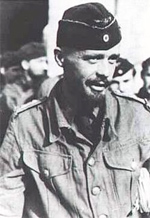 |
The Chronicles carried Part One of this story last month, authored by Walter ("Picho") Hamer. The story follows the exploits of the Nazi submarine U-161 (IXC Class WW II U-boat) under the command of one Korvettenkapitän Albrecht Achilles. Herr Achilles would bring the war home to Costa Rica in one dramatic and successful attack. Achilles joined the Kreigsmarine (German Navy) as a 20-year old in 1934 and, after the war started in 1939, he transferred to U-boat service becoming captain of U-161 in January 1942. He was deployed to Latin America, particularly the western caribbean to harass U.S. shipments of oil from regional refineries. Any shipping passing through the Panama Canal also was game.
Achilles and his boat would end up prowling the Caribbean side of the Americas and sinking fifteen allied ships owned by the U.S. (5), U. K. (3), Canada (2) and one each for Brazil, the Dominican Republic, the Netherlands, Panama and South Africa. Achilles and the crew of U-161 also severely damaged six additional ships. For this effort his boat and crew received the title "ace".
The ship with Panamanian registry mentioned above is the subject of our guest author's story. Although it was Panamanian registry, the ship was in the employ of the United Fruit Company and was used to transport fruit from Costa Rica to the U.S. This freighter, by the name of San Pablo, was moored in Limón harbor at the time of the incident described below.
We left the story last month with U-Boat 161 sneaking into Limón Harbor and taking up position within easy torpedo distance of the freighter San Pablo... but let's have Picho tell the rest of his story (photos and captions provided by GGC for editorial support):
U-161 Statistics
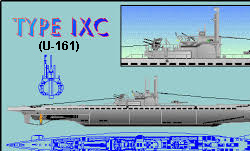 |
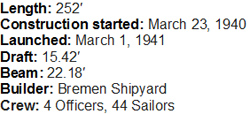 |
"After a quick look around the harbor from periscope depth to assure that he had not been seen, Captain Achilles allowed the big U-boat to settle slowly until it rested on the sandy bottom of the bay. During the night he rose again to periscope depth and maneuvered cautiously to align the submarine with the exit channel, which placed its stern in a line with the lighted wharf where the San Pablo was being unloaded. Torpedoes were loaded into the two stern tubes and readied for firing.
Just before daybreak, another coastal vessel was seen heading toward the submarine barrier in preparation for leaving the port. Achilles waited until the net was fully opened and the departing boat was passing out of the gap, and then gave the order to surface. As soon as the big submarine burst out of the depths its diesel engines started up and began moving it toward the exit channel. Its gun crew ran to the forward deck cannon and fired on the utility launch, stopping it dead in the water and leaving the barrier standing wide open. While the gun crew fired a few random shots into the nearby petroleum tank farm and at a few of the other vessels in the anchorage, Captain Achilles brought the stern into a direct line with the San Pablo and fired the two aft torpedo tubes.
The San Pablo , "Russian Freighter"
 |
 |
Both torpedoes struck the docked freighter amidships, blowing great holes in its side and killing the 23 Costa Rican stevedores that were working in the forward holds. The ship flooded immediately, and sank straight down in a matter of minutes to rest on the bottom alongside the pier. The U-161 made an unimpeded exit from the harbor, the Kriegsmarine battle flag flying from its mast, and disappeared into the lightening sea beyond.
The sinking of the San Pablo had a much wider effect than would normally be caused by the loss of a 30 year old freighter and twenty three civilian non-combatants. The people of Costa Rica were suddenly brought to the realization that their readiness to join the Allied cause could have very real and dangerous consequences. Pacifist political elements quickly raised an outcry against the government’s “hasty” entry into the war and of its failure to prepare properly for the possible results.
There were riotous demonstrations in the streets of San Jose, the capital, demanding immediate improvements in the country’s coastal defenses and a crackdown on internal security. “Why were the blackout rules not being enforced in Limón? Why was there no coastal defense artillery in this, the country’s main port on the Caribbean? How could a submarine enter and leave the harbor without some kind of local help?” These were some of the questions being asked.
In this climate of alarm, even the United States was assigned some of the blame for the incident for not providing the kind of military support that had been implied when Costa Rica entered the war. This placed a brief strain on the relations between the two allies. Like many Latin American countries, Costa Rica had received large numbers of the Germans who migrated to the New World following the end of the First World War. Most of them became well established in the country’s society, and over the years many came to occupy positions of social and financial prominence.
Since the declaration of war in 1941, the government and people of Costa Rica were ambivalent about the disposition of these foreigners whose homeland was now an officially avowed enemy. Rumors had long circulated that the Nazis had seeded the later immigrant flow with deep-cover spies in order to establish a “fifth column” within Latin America. While this allegation was later proven to have some truth to it, there was never any indication that Capt. Achilles received assistance from anyone in Costa Rica in carrying out his mission.
However, the combination of the “fifth column” theory, and the fact that many of the Germans in the country retained their German citizenship, forced the government to bow to the increased pressure brought on by the San Pablo incident. It reluctantly took action against this section of the population by confiscating their properties and businesses and interning them in a concentration camp on the outskirts of San Jose. These actions were contrary to the nature of the peaceful and tolerant Costa Ricans, and caused deep wounds in the social and political fabric of the country that were only healed after the war was over.
In January of the following year, 1943, the San Pablo was patched up and raised and then towed to Tampa to be repaired. Her damage was so extensive, however, that she was declared a total loss and turned over to the U.S. Army to be used as a target for weapons testing and training. She was eventually destroyed in the waters of the Gulf of Mexico nine miles south-southeast of Pensacola, Florida, on September 25. The scattered remains of the old ship later became a popular site for recreational divers, identified in the sport’s guides, for some unknown reason, as “the Russian Freighter.”
On September 27, just two days after the San Pablo’s destruction, the U-161 was sunk by a U.S. Navy patrol plane off of Bahia, Brazil, with the loss of Captain Achilles and all of his crew."
Museo de los Niños
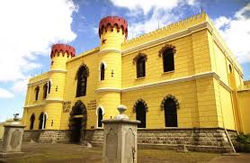 |
Picho mentions the riots in San José following the San Pablo incident and the subsequent crackdown on German (and Italian) families here. At the time, according to a government historian, a number of these people were retained in a penitentiary in San José, which was eventually converted to what is now known as the Museo Nacionál de los Niños (Children's Museum). Another 300-400 people of German and Italian descent were sent to concentration camps in the U.S. These were like the camps that were also used to house some Japanese in the U.S. during that period.
The times during WW II were difficult for all involved and war tensions were high. It would be only four years after the end of World War II and seven years after the San Pablo incident (1949) when a new Costa Rican Republic would be established shortly after a short, bitter civil war in 1948-49. The new constitution for what would be known as the Second Republic, which is also the current one, abolished the military when it went into effect in 1949.
Many thanks to Mr. Walter ("Picho") Hamer for sharing his impressions and this story with us.
And for more on the history of Costa Rica, go here:
History of Costa Rica: Edition 61 - CR History - a Primer, Part I (Pre-Columbian)
History of Costa Rica: Edition 62 - CR History - a Primer, Part II (Spanish Occupation)
History of Costa Rica: Edition 63 - CR History - a Primer, Part III (Modern Era)
¡Pura Vida!
TOP
Ruminations of a Golden Expat
(Part One - Expatriot Strategizing)
GG knowingly wanders into the swamp of potential conflict with this article, maybe even into the quicksand. I started to write this as a single article but I ran out of electrons, so Part One is below and Part Two will be offered next month. Here goes:
 I've been an expat in Costa Rica for eight years now and I offer the following summary of my personal experience and observations below for what it's worth. Take what you can use and leave the rest.
I've been an expat in Costa Rica for eight years now and I offer the following summary of my personal experience and observations below for what it's worth. Take what you can use and leave the rest.
Some will disagree with my ruminations but I'll bet you a plate of gallo pinto that many who have actually experienced living here will snicker in humorous agreement with much of what I'm about to portray. The comments are mostly directed towards U.S. expats or those gringos that would be expats but much of it also fits other English speaking cultures as well as a few other languages. In short, it's a fair commentary for all expats.
Who Moves Here and Why? At any given time, about 10% of the population here, estimated in 2016 at 4,884,000, are expats (see Counting the Uncountables). The biggest number by far is from our northern neighbor, Nicaragua and is estimated at over 300,000. Just how many Nicas are here legally is a question that is almost impossible to answer, much like how many illegals are in the U.S.
Next in line after the Nicaraguans are about 20,000 Colombians. As might be expected, the U.S. leads the native English speaking world here with about 20,000 followed by the Canadians with about 10,000. An additional 60,000 or so are expats from some twelve other countries. So about 110,000 or 2.2% of the population are expats (if you count the Nicaraguan estimate, the expat fraction rises to about 8.6%).
Compare this to the U.S. The estimated non-citizen fraction in the States is about 21,000,000 but that could include as many as 11,000,000 illegals or about 3.1% of the total. With illegals included, that percentage rises to 6.5%.
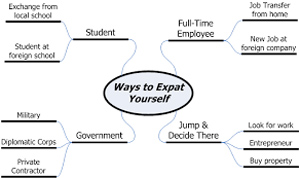 The chart at right, from a press article, shows four of the most common (gringo) types of expats here: 1) students or exchange students, 2) full-time employees, mostly as a job transfer, 3) those that work with or for the government as a diplomat or contractor and 4) entrepreneurs or investors.
The chart at right, from a press article, shows four of the most common (gringo) types of expats here: 1) students or exchange students, 2) full-time employees, mostly as a job transfer, 3) those that work with or for the government as a diplomat or contractor and 4) entrepreneurs or investors.
Actually GG believes this chart is missing one very important branch, that of the retiree or those that are lovingly referred to here as "pensionados", old dudes like GG. That "Jump and Decide There" category is more related to the escaping from or escaping to crowd, of which there are a significant number. A friend of mine jokingly says that many of the expats that come here are unwanted or wanted in other places, including the U.S.
As usual, comments and suggestions are welcome at gg@goldengringo.com.
¡Solo Bueno!
TOP
Travel Quote of the Month
Better far off to leave half the ruins and nine-tenths of the churches unseen and to see well the rest; to see them not once, but again and often again; to watch them, to learn them, to live with them, to love them, till they have become a part of life and life’s recollections.
– Augustus Hare |
What's-in-a-Word
Answer to Que Es Eso
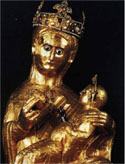
This is a photo of one of the two "life-size" Virgin Mary statues found accidentally on a beach on Isla de Coco. Remember, "life-size" was considerably smaller in 1820, around 5' 5" versus today at 5' 10". The statue weighs 84.7 kg or 186 pounds and, at the price of gold in mid-November 2016 , the metal alone would be worth more than $3.4 million. And yes, it is a queen, the Queen of Heaven.
Aguinaldo
Costa Rica workers receive a 13th month of wages or salary based on the average of their earnings for the previous 12 months. The payment, called an aguinaldo, is paid just before Christmas which may explain the wider smile on many people's faces about that time (it also funds the traditional Christmas week vacation in many cases).
TOP
ROMEO Corner
(Retired Old Men Eating Out)
Kúkula, Quepos
Location: In barrio Boca Vieja after exiting Quepos centro, about 1/4 mile on the left.
Hours: Lunch and Dinner Tuesday thru Sunday
Parking: Ample on the streets surrounding the restaurant.
Contact: Tel.: 2777-2735; Email: N/A; Website: N/A
Reviewing ROMEOS: Lucius H., Bob N.
To Review Our Rating System and Procedure, go here: R.O.M.E.O. Rating System
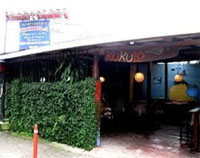 This restaurant was last reviewed in July of 2013 (go HERE).
This restaurant was last reviewed in July of 2013 (go HERE).
LIttle has changed physically since the last review. The atmosphere is basic but pleasant, the owner Ranier still serves people as he did us this night and the noise level from the street serves to remind you where you are.
We gave Kúkula a composite rating for atmosphere of 3.0 out of five sloths maximum.
There is still a good selection of varied dishes but fresh seafood still predominates. GG had a crab dip with fried patacones (a patacone is a platano scored, sliced about a quarter inch thick and deep fried into discs that look like little stars. The dip is spread on the patacones. Delicious. I followed that with a brochette of shrimp which also were fresh and which were accompanied by the proverbial and traditional black beans, plain rice and a small salad. Very tasty.
My dining partner had guacamole dip followed by a pan fried , breaded piece of sea bass which he also found very tasty.
We gave Kúkula a composite score of 4.5 for food quality.
|
 |
 .8 .8 |
$$$.3 |
Value Index = |
We were again served by the owner Ranier. He was efficient and friendly. We gave a composite rating of 3.8 sloths for service which yields an overall rating of 3.8 sloths for atmosphere, food quality and service.
For my two courses, the crab dip and the shrimp, plus a soft drink my bill was $12,500 or about $22. My dining partner had just about the same bill. GG thought there had been a bit of an increase in cost since the last review (so what hasn't gone up?).
We gave the Kúkula a composite score on cost of 3.3$ which yields a Value Index of 3.8/3.3x100= 115, virtually the same rating as we gave it in 2013.
Consistency in quality and value still being the heart of a good restaurant, we can easily recommend the Kúkula for a good meal.
Golden Gringo Chronicles Novel and E-Books Now Available!

The story of the Golden Gringo Chronicles is also available as a hard copy novel of 192 pages available through Amazon and all major online retailers. ($9.95)
Amazon link: GGC, the Book. (Kindle Edition available)
Follow GG through the first six years of his odyssey in making the decision to retire in Costa Rica, overcoming the trials and tribulations of moving and obtaining residency there and the fun and experience of actually living in Ticoland.
Ride along with the Golden Gringo as he learns about the rich, varied culture of Costa Rica, the incredible bio diversity, the charming nature of the Costa Rican people and the ease with which a sometimes clueless ex-pat can assimilate into a small southwestern town on the Pacific coast.
Whether you are already a Costa Rican resident, someone contemplating a move here or just a traveler who enjoys different cultures, you will find the Golden Gringo Chronicles interesting, entertaining and informative about Costa Rica.
A narrative version of the Golden Gringo Chronicles is now also available as a trilogy of E-books in formats compatible with virtually all electronic platforms.
Part 1: (FREE!)
Leaving the Homeland
Part 2: ($3.99)
The Early Years
Part 3: ($3.99)
Becoming Tico, Maybe
Click on Part Number above for E-book sample downloads or click the price above right for purchase.
(The best price is on Part 1; it's FREE)
Opt-In Here to Receive Your Free Copy Monthly
The Golden Gringo Chronicles is a free newsletter that is non-political, non-commercial and, hopefully, entertaining. By signing up you will receive an email each month around the first of the month giving you the links to the latest edition as well as to each individual feature and departmental section.
CLICK HERE TO SIGN-UP FOR THE
GOLDEN GRINGO CHRONICLES
or Email me at gg@goldengringo.com
Website: www.goldengringo.com

The Golden Gringo
Pura Vida!
To Contact GGC World Headquarters (yuk, yuk) to make comments, suggest topics or criticize my bad jokes, just send an email to: gg@goldengringo.com.
Be pithy but kind; I'm sensitive.
Unsubscribe from Golden Gringo Chronicles




 But maybe you've got billions of colones and you'll be lucky to hit a great exchange rate, like 5.555 colones per dollar. A recent quirk in the system used by BCCR put that rate into play for a (very) short period recently. That means buying $1,000 would have cost you only 5,555 colones instead of the 561,000 colones it should have based on the real rate above. The press reported that two different transactions buying dollars were completed during this period, one for $400,000 and one for $63,000. BCCR authorities were busy getting their money back following those deals.
But maybe you've got billions of colones and you'll be lucky to hit a great exchange rate, like 5.555 colones per dollar. A recent quirk in the system used by BCCR put that rate into play for a (very) short period recently. That means buying $1,000 would have cost you only 5,555 colones instead of the 561,000 colones it should have based on the real rate above. The press reported that two different transactions buying dollars were completed during this period, one for $400,000 and one for $63,000. BCCR authorities were busy getting their money back following those deals. Back in 2013, in the midst of furious competition for a birth in the upcoming FIFA World Futbol Games scheduled for 2014, the Tico national team met the U.S. national team in Denver and fought it out to a 1-0 win for the U.S., in the middle of a snow storm (see
Back in 2013, in the midst of furious competition for a birth in the upcoming FIFA World Futbol Games scheduled for 2014, the Tico national team met the U.S. national team in Denver and fought it out to a 1-0 win for the U.S., in the middle of a snow storm (see 


 The national government of Costa Rica finds itself in some odd commercial situations, unfortunately it is often by bureaucratic design. One division of the government,
The national government of Costa Rica finds itself in some odd commercial situations, unfortunately it is often by bureaucratic design. One division of the government,  The Costa Rican government is also in the liquor production business, having started it as a monopoly in 1853. That's only 32 years after
The Costa Rican government is also in the liquor production business, having started it as a monopoly in 1853. That's only 32 years after 
 The legend has it that back in 1820 the Spanish church in Lima, Peru feared that it's treasure would be confiscated in an uprising there. They contracted a British privateer to haul the treasure away but, in keeping with good pirate fashion, he decided to abscond with the loot himself and the story goes he buried it on Isla de Coco. The first Costa Rican governor of the island spent 18 years (circa 1790) trying to find the treasure to no avail. Over the ensuing years treasurer hunters, even using sonar and other modern detection equipment, also failed to turn up the loot.
The legend has it that back in 1820 the Spanish church in Lima, Peru feared that it's treasure would be confiscated in an uprising there. They contracted a British privateer to haul the treasure away but, in keeping with good pirate fashion, he decided to abscond with the loot himself and the story goes he buried it on Isla de Coco. The first Costa Rican governor of the island spent 18 years (circa 1790) trying to find the treasure to no avail. Over the ensuing years treasurer hunters, even using sonar and other modern detection equipment, also failed to turn up the loot. Now, almost 200 years later, just a few weeks ago, a couple of park rangers were wandering one of the beaches on Coco to check turtle nest damage after a big storm and noticed the corner of a wooden chest sticking out of the sand, Upon investigation, it turned out to be the treasure. So far the findings have produced the following:
Now, almost 200 years later, just a few weeks ago, a couple of park rangers were wandering one of the beaches on Coco to check turtle nest damage after a big storm and noticed the corner of a wooden chest sticking out of the sand, Upon investigation, it turned out to be the treasure. So far the findings have produced the following: 
 The real news in November came in the form of rain, lots of rain, some of it with incredibly strong winds. October and November are the high months of the rainy season in Costa Rica and this year they lived up to their reputation. By mid-October the government had issued a "green" alert for residents to watch out for mud slides, falling trees and flooding rivers. Some areas, particularly the Nicoya and Osa peninsulas, got four or five inches in a few hours. One report from the Osa measured as much as 400 mm (16 inches) over a three day period, causing serious flooding in the larger towns there like Golfito and Puerto Jimenez. While we in the Quepos area got plenty of rain, it was not that severe.
The real news in November came in the form of rain, lots of rain, some of it with incredibly strong winds. October and November are the high months of the rainy season in Costa Rica and this year they lived up to their reputation. By mid-October the government had issued a "green" alert for residents to watch out for mud slides, falling trees and flooding rivers. Some areas, particularly the Nicoya and Osa peninsulas, got four or five inches in a few hours. One report from the Osa measured as much as 400 mm (16 inches) over a three day period, causing serious flooding in the larger towns there like Golfito and Puerto Jimenez. While we in the Quepos area got plenty of rain, it was not that severe. Otto ended up as a Cat 2 just north of the border between Costa Rica and Panama and on November 24 it smashed into southeast Nicaragua near an area called Greytown (red
Otto ended up as a Cat 2 just north of the border between Costa Rica and Panama and on November 24 it smashed into southeast Nicaragua near an area called Greytown (red 



 To see how far the Chronicles have come, or just for a good laugh, check out the first edition (which was subsequently labeled Edition "0") here:
To see how far the Chronicles have come, or just for a good laugh, check out the first edition (which was subsequently labeled Edition "0") here:  Eventually GG hit upon the name Golden Gringo Chronicles and renamed the newsletter using that title. Gringo (the more polite word is Norteamericano) is a mildly pejorative term in Costa Rica; Ticos smile when you use that term on yourself. The Golden part of the name was chosen for two reasons; 1) retirement time might also be thought of as the "golden" years and 2) I felt fortunate that I was able to retire here, I was "golden" or lucky in that regard.
Eventually GG hit upon the name Golden Gringo Chronicles and renamed the newsletter using that title. Gringo (the more polite word is Norteamericano) is a mildly pejorative term in Costa Rica; Ticos smile when you use that term on yourself. The Golden part of the name was chosen for two reasons; 1) retirement time might also be thought of as the "golden" years and 2) I felt fortunate that I was able to retire here, I was "golden" or lucky in that regard.









 I've been an expat in Costa Rica for eight years now and I offer the following summary of my personal experience and observations below for what it's worth. Take what you can use and leave the rest.
I've been an expat in Costa Rica for eight years now and I offer the following summary of my personal experience and observations below for what it's worth. Take what you can use and leave the rest. The chart at right, from a press article, shows four of the most common (gringo) types of expats here: 1) students or exchange students, 2) full-time employees, mostly as a job transfer, 3) those that work with or for the government as a diplomat or contractor and 4) entrepreneurs or investors.
The chart at right, from a press article, shows four of the most common (gringo) types of expats here: 1) students or exchange students, 2) full-time employees, mostly as a job transfer, 3) those that work with or for the government as a diplomat or contractor and 4) entrepreneurs or investors. 
 This restaurant was last reviewed in July of 2013 (go
This restaurant was last reviewed in July of 2013 (go 




